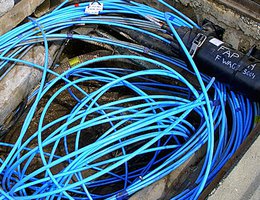
The new Internet economy ran over telecommunication lines that reached all the way around the world. Most of those lines were made of fiber-optic cables — glass fibers that carry light waves that transmit digital signals. One of the largest owners of these fiber-optic networks was a Nebraska-born company — Level 3.

By the end of the 20th century, Level 3 Communications Inc. operated a 16,000-mile network of fiber-optic cable that connected more than 50 urban markets in North America plus cities in Europe. It began as a spin-off of the Omaha-based Peter Kiewit Sons’ construction company. Level 3 moved to Broomfield, Colorado in 1997.
Fiber-optic cable replaced copper wire as the basic transmission medium in the world’s telephone and computer communications systems. Much of Level 3’s network was built along railroad right-of-way, including Omaha-based Union Pacific Railroad tracks.
In part because of this fiber-optic network, Omaha emerged as a leader in the telecommunications industry. Dr. Wiley McKinzie, dean of the College of Applied Science and Technology at Rochester Institute of Technology, has said,
"Omaha is the hub, if not the Mecca, of the burgeoning information technology services industry."
U.S. News and World Report, in their September 1, 1997 issue wrote,
"The city on the Missouri River has emerged as a big telecommunications and computing hub, while preserving its traditional strengths. . . . Omaha is benefiting not only because it sits astride major East-West and North-South fiber-optic lines, but also because it has a backup phone switching center for the entire city."
Omaha was also the telemarketing capital of the U.S. — for better or worse, since many people did not enjoy receiving sales calls over the phone. To be fair, much of the telemarketing industry was dedicated to servicing incoming catalog sales.
Finally, one of the largest online brokerage companies, Ameritrade, is also based in Omaha.
With all of this activity, Forbes magazine rated Omaha in the top ten cities for nurturing information technology companies in the United States in its January 1995 issue.

Fiber optics converts voices and computer data into pulses of light and sends it through hair-like fibers to their destinations, where they are converted back into sound or electronic computer information. Fiber-optic lines allow much higher volumes of information to flow than copper wires. Advances in fiber optics and other systems steadily increase the speed and volume of information that can flow from point to point. Sending large amounts of information down an optical fiber is done by encoding many separate streams of data as pulses of light of different colors, so that they can travel along the fiber without interfering with each other. As the equipment at either end of the fiber becomes more sophisticated, the number of channels and the capacity of each channel increase even though the fiber itself is unchanged.
High-capacity lines, known as broadband lines, are valuable because they can carry so much information so fast. Cheap, broad bandwidth could lead to new products and higher demand for existing products. Video telephones with high-quality pictures became as affordable as an ordinary phone in the late 1990s. Downloading an entire movie over the computer became as economical as downloading a single photograph was then.

Level 3 essentially acted as a wholesaler of time and space on its fiber-optic network. Its customers were large communications companies that then resold the bandwidth to individual business and private customers.
What is the theoretical limit of the rate at which information can be sent down an optical fiber? A group of researchers at Lucent Technologies’ Bell Laboratories found that the limit is far beyond the reach of 1990s’ technology, which meant that there was plenty of room to increase capacity in the future.
It is somewhat ironic that computer technology industries like Level 3 experienced economic woes in the early 2000s that paralleled the farm crisis of the 1980s. Like the farmers in the 1980s, Level 3 and similar technology industries suffered a major drop in their business. Level 3 saw the price per share of its stock drop from a high in 2000 of $140+ to a low of $3+ per share in July of 2001. In January 2003, the stock was trading in the $5 per share range. Like the farmers of the 1980s, services and products provided by technology companies appeared to exceed the demand for them, at least in the short term. Foreign markets declined, and the investments in equipment resulted in heavy debts that were difficult to pay off. Like the farmers of the 1980s, there have been many computer-related companies that no longer exist.
Will the computer-related technology companies like Level 3 survive and see their profits rebound in the future? Will Nebraska maintain its competitive edge in the telecommunications and computer technology arena? Only time will tell.